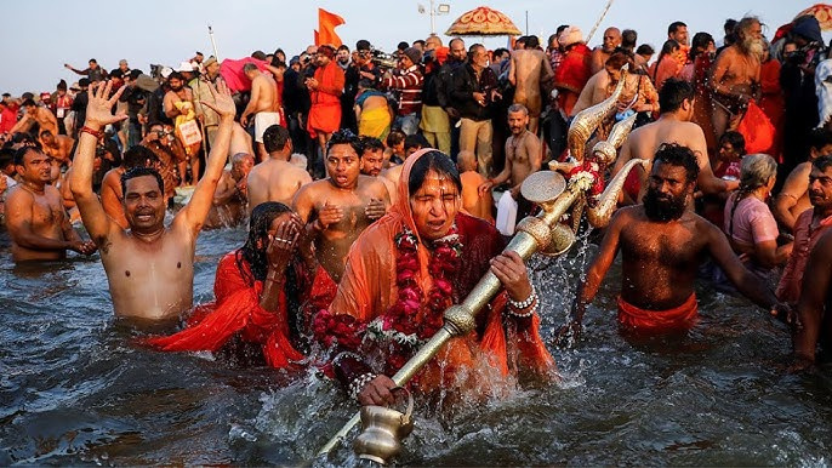On January 13, despite the cold and foggy weather in Prayagraj, tens of thousands of devotees are expected to gather along the banks of the Ganga for the Maha Kumbh, also known as the Poorna Kumbh, held once every 12 years. They will camp in tents, take ritualistic dips in the holy river, and participate in a festival that blends mythology, faith, and cultural heritage.
What is the Kumbh Mela?
The Kumbh Mela is one of the largest gatherings of devotees in the world, held periodically in four cities; Prayagraj, Haridwar, Nashik-Trimbakeshwar, and Ujjain. It is celebrated every 12 years, with each location hosting the festival based on specific planetary alignments.
The word kumbh means pitcher, symbolizing the vessel that carried amrita (the elixir of immortality) in Hindu mythology. According to legend, when the Devas (gods) and Asuras (demons) churned the ocean, the elixir was contained in a kumbh. To prevent the Asuras from obtaining it, Jayant, the son of Indra, fled with the pot, spilling drops of amrita at four locations: Haridwar, Prayagraj, Ujjain, and Nashik. This mythological event is commemorated at the Kumbh Mela.

The Four Sites and Their Significance
Each Kumbh Mela site is located on the banks of a sacred river:
- Haridwar: On the Ganga River.
- Prayagraj: At the confluence (*sangam) of the Ganga, Yamuna, and the mythical Saraswati.
- Ujjain: On the Kshipra River.
- Nashik-Trimbakeshwar: On the Godavari River.
When celestial alignments occur, such as Jupiter entering specific zodiac signs, these cities host the Kumbh Mela. For instance, when Jupiter is in Taurus and the Sun and Moon in Capricorn, the Kumbh is held in Prayagraj.
At the Kumbh Mela, devotees believe that bathing in the river during this auspicious time washes away sins and accrues spiritual merit (punya). Many stay on the riverbanks, immersing themselves in spiritual practices, while others, called kalpwasis, take a temporary break from material pursuits to focus on spirituality.
The festival is also a meeting ground for sadhus and holy men, especially the akhadas (ascetic groups), who attract curious onlookers and devotees seeking blessings and guidance.
The Kumbh Mela has long been a hub of commerce and cultural exchange. Historical records note the presence of Venetian coins and European toys in its markets, highlighting its significance as a trade centre. Today, the Mela continues to boost local economies while serving as a platform for religious and cultural interactions.
The Kumbh Mela is more than a festival; it is a confluence of mythology, history, and the enduring faith of millions.
Source / Image Credit : ET Now News , ABC News - The Walt Disney Company
What is the Kumbh Mela?
The Kumbh Mela is one of the largest gatherings of devotees in the world, held periodically in four cities; Prayagraj, Haridwar, Nashik-Trimbakeshwar, and Ujjain. It is celebrated every 12 years, with each location hosting the festival based on specific planetary alignments.
The word kumbh means pitcher, symbolizing the vessel that carried amrita (the elixir of immortality) in Hindu mythology. According to legend, when the Devas (gods) and Asuras (demons) churned the ocean, the elixir was contained in a kumbh. To prevent the Asuras from obtaining it, Jayant, the son of Indra, fled with the pot, spilling drops of amrita at four locations: Haridwar, Prayagraj, Ujjain, and Nashik. This mythological event is commemorated at the Kumbh Mela.

The Four Sites and Their Significance
Each Kumbh Mela site is located on the banks of a sacred river:
- Haridwar: On the Ganga River.
- Prayagraj: At the confluence (*sangam) of the Ganga, Yamuna, and the mythical Saraswati.
- Ujjain: On the Kshipra River.
- Nashik-Trimbakeshwar: On the Godavari River.
When celestial alignments occur, such as Jupiter entering specific zodiac signs, these cities host the Kumbh Mela. For instance, when Jupiter is in Taurus and the Sun and Moon in Capricorn, the Kumbh is held in Prayagraj.
At the Kumbh Mela, devotees believe that bathing in the river during this auspicious time washes away sins and accrues spiritual merit (punya). Many stay on the riverbanks, immersing themselves in spiritual practices, while others, called kalpwasis, take a temporary break from material pursuits to focus on spirituality.
The festival is also a meeting ground for sadhus and holy men, especially the akhadas (ascetic groups), who attract curious onlookers and devotees seeking blessings and guidance.
The Kumbh Mela has long been a hub of commerce and cultural exchange. Historical records note the presence of Venetian coins and European toys in its markets, highlighting its significance as a trade centre. Today, the Mela continues to boost local economies while serving as a platform for religious and cultural interactions.
The Kumbh Mela is more than a festival; it is a confluence of mythology, history, and the enduring faith of millions.
Source / Image Credit : ET Now News , ABC News - The Walt Disney Company







